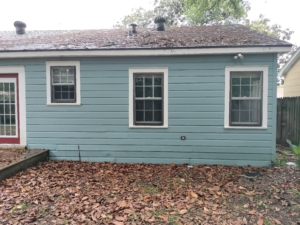High moisture levels under the house?
Buckling in wood floors can occur for a number of reasons, but moisture is often the root cause. For those of us living in the Gulf South, high humidity levels and exposure to moisture from underneath the house are common factors that lead to buckling wood floors. It’s likely that moisture is accumulating under your house and causing the wood floors to buckle. Proper ventilation can help to reduce humidity levels and prevent moisture from becoming trapped under the house.
To repair the buckled wood floors, you will need to identify the source of the moisture and address it first. This may involve improving the ventilation under the house, fixing any plumbing leaks, or addressing drainage issues. Once the moisture problem has been resolved, you can then focus on repairing the floors themselves.
The extent of the damage will determine the best approach for repairing the floors. In some cases, the buckled boards may need to be removed and replaced. In other cases, the boards can be sanded down and refinished. It’s important to work with a qualified flooring contractor who can assess the damage and recommend the best course of action for your specific situation.
Overall, addressing the moisture issue is key to preventing further damage and ensuring the longevity of your wood floors.
Once the crawl space is ventilated properly, is it possible my floors may buckle even more from the change in conditions?
It’s unlikely that proper ventilation in your crawl space will cause your floors to buckle even more. In fact, improving ventilation can help to prevent further damage to your floors by reducing moisture levels and preventing the accumulation of moisture under your home.
However, it’s important to note that if your floors have already been damaged by moisture, improving ventilation alone may not be enough to reverse the damage. If the damage is extensive, you may need to replace some or all of the affected floorboards. A qualified flooring contractor can assess the damage and recommend the best course of action for your specific situation.
It’s also worth noting that proper ventilation alone may not be enough to prevent moisture buildup under your home. You may also need to address other potential sources of moisture, such as plumbing leaks or poor drainage. A qualified contractor can help you identify and address these issues as well.
Overall, improving ventilation in your crawl space is an important step in preventing further damage to your floors, but it may not be the only step you need to take. It’s important to work with qualified contractors to assess the damage and develop a comprehensive plan for repairing and preventing future damage to your floors.

Buckling Wood Floors

Partially Blocked Ventilation

Deterioration at Floor Structure

More Deterioration at Floor Structure

Missing Ventilation at Crawl Space

Why are my wood floors buckling?
High moisture levels under the house?
Once the crawl space is ventilated properly, is it possible my floors may buckle even more from the change in conditions?
Buckling Wood Floors
Partially Blocked Ventilation
Deterioration at Floor Structure
More Deterioration at Floor Structure
Missing Ventilation at Crawl Space